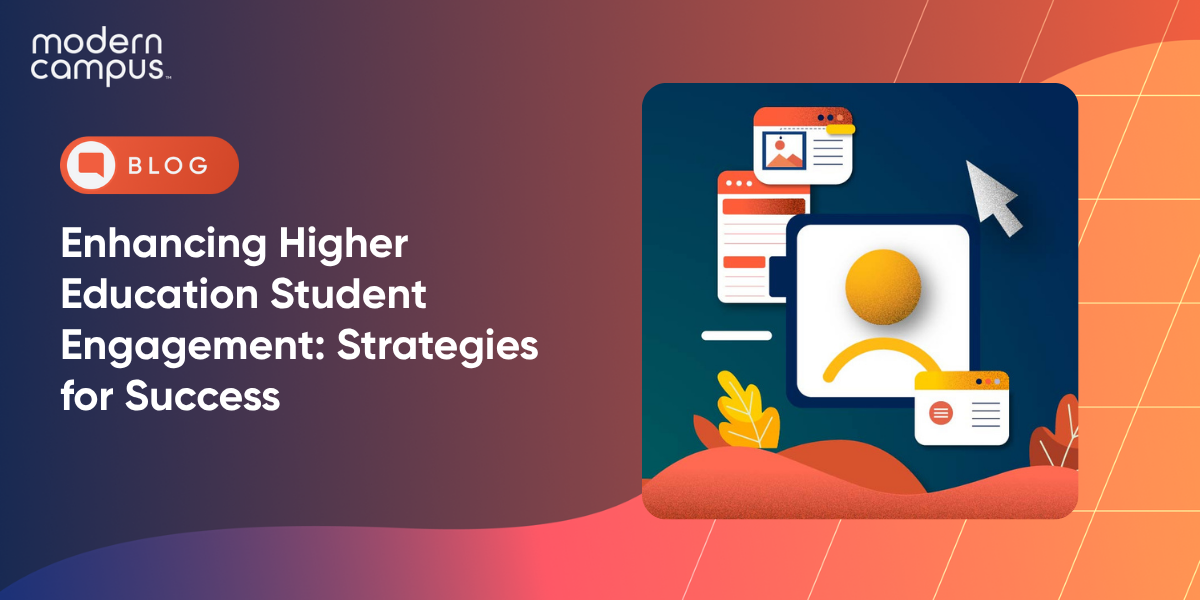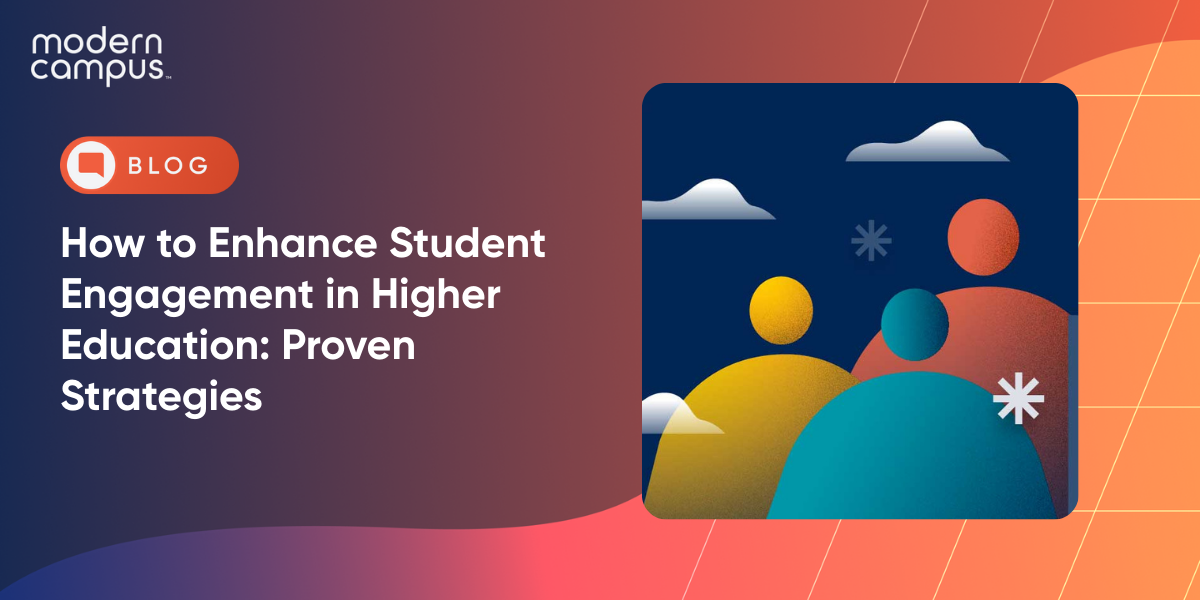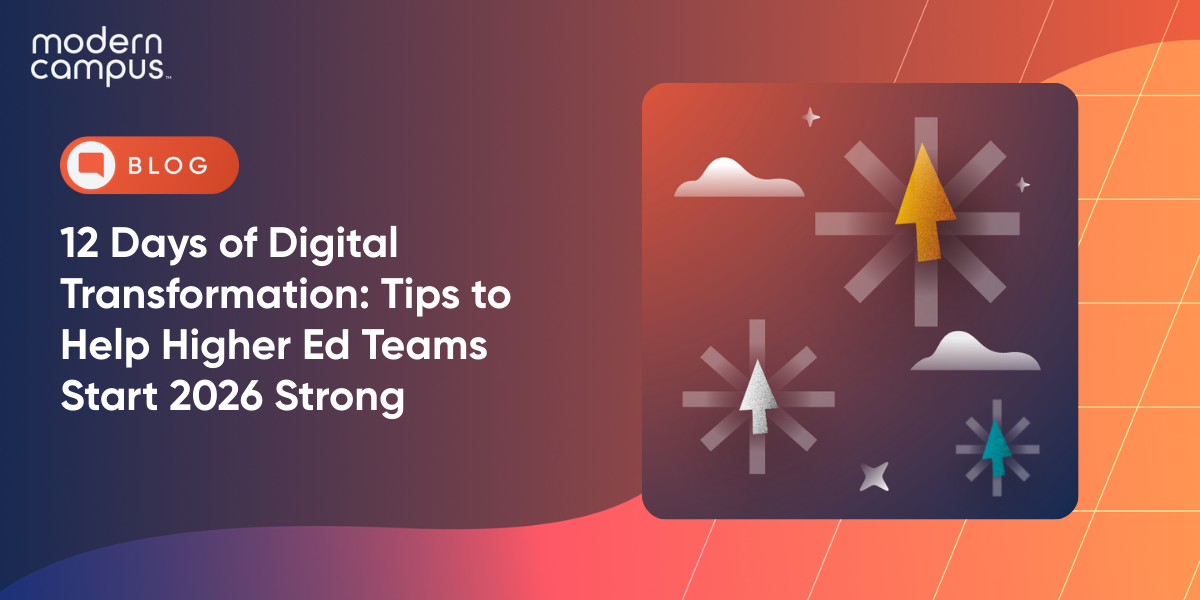Enhancing Higher Education Student Engagement: Strategies for Success
Higher education student engagement has never been more vital or complex. Nearly a third of students question the value of a degree, and over half of prospective students explore non-traditional learning options. With these trends, institutions must do more than deliver a quality education. They need to provide a dynamic, personalized student experience that supports academic success, promotes student involvement and fosters a meaningful connection to campus life.
Student engagement is now one of the top predictors of retention and overall satisfaction, making it a strategic priority for colleges and universities nationwide. However, many institutions still struggle to keep pace with evolving expectations. Students, especially digital natives, expect intuitive platforms, seamless communication and flexible learning pathways that reflect their goals. When these elements are missing, engagement drops and the risks to retention and revenue grow.
Fortunately, with the right student engagement software and campus-wide strategies, higher ed leaders can foster student participation both inside and outside the classroom. From co-curricular opportunities to collaborative learning models, we'll explore proven, tech-enabled student engagement strategies to increase student success at every stage of the learner journey.
Why Higher Education Student Engagement Is a Priority
High levels of engagement have been linked to stronger academic outcomes, better retention rates and increased overall satisfaction. Yet many institutions still rely on outdated approaches that don’t reflect how students learn, communicate or connect. To thrive, institutions must view student engagement as a strategic lever that impacts every aspect of the educational experience from academic advising to extracurricular activities.
Modern student engagement strategies must account for the full scope of a student’s journey. Engagement is about how students feel supported, seen and empowered as part of their campus community. From onboarding to graduation and lifelong learning, engaging students requires a proactive, data-informed approach backed by tools designed specifically for higher ed environments.
Engagement as the Foundation for Retention and Success
Engagement is a strong predictor of student persistence. Students who feel connected to their institution are more likely to stay enrolled past the first year. When students engage in campus events, student organizations and other aspects of campus life, they build meaningful relationships that support their mental health, academic success and overall well-being. Connection fosters belonging, an essential ingredient for retention in higher ed.
Additionally, student participation in co-curricular engagement activities often translates to stronger academic performance. These experiences give students a chance to apply what they’re learning in the classroom to real-world contexts, deepening their understanding of course material while developing essential soft skills.
Measuring engagement through platforms and analytics helps staff identify students who may be at risk of stopping out, giving institutions time to intervene with support services or academic advising before it’s too late.
Shifting Student Expectations in a Digital-First World
Students expect campus cultures that reflect their values, offer flexibility and support their diverse learning needs. That means easy access to information, responsive communication and technology that mirrors the tools they already use in everyday life. Whether through student engagement platforms or mobile-first student portals, digital tools now play a central role in how students interact with their campus and navigate their learning process.
For example, online discussions and virtual events offer ways to reach students who may not participate in traditional formats. Personalized communication powered by student engagement software can guide students through complex tasks like financial aid or registration, increasing engagement through clarity and convenience. When institutions meet students where they are digitally, culturally and academically, they’re far more likely to encourage enrollment, academic success and lasting connections.
Practical Ways to Engage Students In and Outside the Classroom
Student engagement is cultivated through everyday interactions, meaningful experiences and a campus culture that makes students feel seen and supported. To boost engagement in both academic and co-curricular settings, institutions need to create opportunities for participation that align with student interests and needs. From collaborative learning in small groups to student organizations and events, engagement should feel natural, not forced.
Modern engagement strategies blend pedagogical innovation with intentional student affairs programming to empower students to get involved, build connections and thrive throughout their college experience.
Active and Collaborative Learning Strategies
One of the most effective ways to increase student engagement is to shift from passive lectures to active learning models. Group discussions, real-world simulations, peer-led projects and flipped classrooms all help students interact with the course material on a deeper level. These methods encourage students to take ownership of their learning process, which leads to better academic outcomes and a stronger sense of purpose.
Collaborative learning also boosts social connections. Small groups can provide safe spaces for students to explore ideas, debate topics and build academic confidence, especially for those who may not feel comfortable speaking in large lecture halls. By facilitating group-based problem-solving and peer instruction, teachers can increase student participation and foster an inclusive, student-centered classroom.

Making the Most of the Co-Curricular Experience
Beyond academics, co-curricular engagement is a powerful driver of student success. Student involvement in extracurricular activities, student groups and campus events strengthens ties to the institution and promotes a sense of community. These experiences can be especially impactful for first-year students or transfer students looking to find their place on campus.
Many institutions are now using student engagement platforms to promote events, track participation and measure engagement over time. These tools help staff understand how students are interacting with campus life and where gaps might exist.
Encouraging students to explore clubs, attend workshops or lead their own initiatives fosters personal growth while reinforcing their connection to the broader campus experience. Students develop leadership and teamwork skills, while institutions see improved satisfaction and retention rates.
Boost Student Engagement Through Personalization and Technology
Higher education must embrace personalization to remain relevant and effective. Modern engagement involves providing students with timely, relevant and actionable information that resonates with their unique goals. Personalized engagement is a key differentiator that separates thriving institutions from those that struggle to connect with current students.
With the help of student engagement software, colleges and universities can now scale personal touchpoints without overwhelming staff. Whether it’s guiding prospective students through the admissions process or helping current students stay on track academically, technology can create a seamless, engaging and well-informed journey from day one.
Using Data to Encourage Students at the Right Time
One of the most valuable assets institutions have is data. By tracking key engagement signals like attendance at campus events, participation in discussion forums or logins to online learning platforms, schools can identify students who may be disengaging and respond quickly. Student engagement platforms equipped with built-in analytics help staff identify students who are under-engaged and intervene with the right support at the right time.
Targeted outreach is directly related to retention and student success. Whether through automated nudges about academic advising appointments or personalized reminders for financial aid deadlines, encouraging students through well-timed messages can make a significant impact. And because much of this communication can be automated, staff can focus their time on deeper student support.
Customizing the College and Campus Experience for Every Learner
No two students follow the same path, so offering flexible, student-centered choices is critical. Personalized course schedules, mobile-friendly campus apps and interest-based student portals all help students feel like their experience is truly theirs. These tools empower students to navigate college life more confidently and make informed decisions about their academic programs, extracurricular activities and career pathways.
Incorporating student feedback into program design is another way to increase student engagement. When students see their input reflected in campus improvements, they feel heard and valued. Gather thoughts about adding new support services, updating dining options or enhancing online learning features. This sense of agency fosters a stronger connection between students and their institution, increasing engagement and long-term satisfaction with the educational experience.
Integrating Career Pathways to Strengthen the College Experience
Both traditional and non-traditional learners want to understand how their academic journey will lead to real-world opportunities. Meeting this expectation involves clearly connecting academic programs to career pathways. Students are more likely to persist when they see the relevance of their coursework and co-curricular involvement to future employment.
Career integration can be woven into the daily student experience through thoughtful advising, skill-building campus events and career-focused tech tools. By helping students envision and plan their professional futures early on, institutions can foster stronger motivation and deeper participation in both academic and extracurricular learning.
Connecting Coursework to Real-World Labor Market Needs
Many institutions are turning to real-time labor market data to guide students toward high-demand career paths. When students understand which industries are growing, what skills are required and how specific programs align with those trends, they can make better decisions about their academic plans. This also helps students engage more meaningfully with course material, knowing it’s preparing them for real, attainable goals.
Using student engagement platforms that integrate with academic program catalogs or advising tools makes this process easier. Students can explore potential careers, identify related degrees or micro-credentials and map out a path that fits their interests and aspirations. Aligning the academic experience with career outcomes is especially important for non-traditional and adult learners, who often return to higher ed with specific goals in mind.
Guiding Students with Personalized Career Tools
Generic career advice doesn’t cut it anymore. To truly boost engagement, institutions must provide tools that personalize the exploration and planning process. Whether it’s persona-based career guides, dynamic search tools or dashboards that track academic and career milestones, the goal is to empower students to take control of their futures.
These tools are particularly effective when paired with strong academic advising and co-curricular support. Advisors and faculty can use student data to tailor guidance, helping students align their educational experience with their personal and professional goals. Meanwhile, features like resume builders, internship portals and virtual career fairs increase student participation by making career development feel accessible, actionable and directly related to their time on campus.

Unlocking Long-Term Value: Engaging Students Beyond Graduation
Many institutions are now recognizing the lifelong value of staying connected with their alumni not just for fundraising or prestige but to offer ongoing education, networking and professional development. By fostering strong campus connections during a student’s time in college, institutions can lay the foundation for deeper, lifelong engagement.
Creating a culture of continuous learning and support helps institutions build communities that extend well beyond campus walls. Whether students return for advanced credentials or stay involved as mentors or advocates, long-term engagement is a key part of a successful learner-to-earner lifecycle.
Creating Alumni Connections Through Meaningful Campus Relationships
Students who feel supported and involved during college are more likely to stay engaged as alumni. Encouraging participation in student organizations, mentorship programs and campus events during their studies fosters loyalty that can last a lifetime. These meaningful relationships help students feel like they’re part of a community they’ll remain invested in even after graduation.
Many campuses are now leveraging student engagement platforms to maintain communication with alumni and track involvement in lifelong learning opportunities. By offering value beyond the degree, such as networking events, continuing education discounts or career services, universities can demonstrate an ongoing commitment to their graduates’ success.
Supporting Lifelong Learning with Flexible Program Options
Offering flexible, career-aligned education options like micro-credentials, certificates and online learning programs ensures alumni can continue their professional development through the same institution they trust. These offerings also drive revenue and reinforce institutional relevance in a crowded marketplace.
Institutions that simplify access to these programs through intuitive course browsing, seamless enrollment processes and personalized marketing can encourage more students to return. When your campus becomes a go-to hub for lifelong learning, it shows current students that the relationship doesn’t end with a diploma. Instead, it evolves into a partnership grounded in shared goals and long-term success.
Transform Your Student Engagement Strategy
Student engagement is the heartbeat of a thriving institution. As student expectations evolve, so must the strategies we use to connect, motivate and retain them. By integrating collaborative learning, personalized technology, career-aligned academic programs and co-curricular opportunities, institutions can increase student engagement across every phase of the learner journey. When students feel supported, seen and empowered, the results speak for themselves: higher retention, improved outcomes and deeper institutional loyalty.
At Modern Campus, we’re proud to help institutions deliver transformative student engagement experiences. Our student engagement platforms and tools are built exclusively for higher education, empowering your team to measure engagement, personalize communication, streamline support services and cultivate lifelong learning relationships. Request a demo to boost engagement and build a stronger campus community from prospective students to lifelong learners.
Last updated: April 21, 2025



